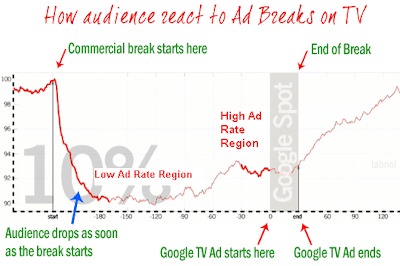
It is clearly visible that as soon as the TV commercial starts, the audience suddenly looses interest and levels of interest for the audience drops significantly. The interest level remains at that low level for almost 2 minutes or more for the tv ad commercial - somewhere in between the ad break timeslot.
So what's the conclusion from above? Only the first few seconds of the ad break are worth showing the tv ads as a part of Marketing Campaign. Immediately after the ad starts, the audience simply looses interest and either dont look at the tv commercials or switches the channel. Hence, the conclusion from this graph is that there is not much of significance in putting up ads in this kind of timeslot as a part of marketing campaign.
Now have a look at what happens when the tv ad starts to end. Just around 30 seconds before the end of the TV ad, the audience interest again start picking up. The reason for this behavior can be explained on two facts:
1) The audience who did not switch the channel got the necessary lengthy break, diverted their attention to something else, got a chance to soothe their eyes during the break and hence, they are now coming back to the favourite TV program.
2) The audience who switched to another channel have now completed their channel surfing and now coming back to the channel of their favourite program in an anticipation of completion of TV ad.
Ultimately, the conclusion is that the middle segment of ad break (which may be from 1 minute to 2.5 minutes before the end of the TV Ad) is NOT fruitful for the marketing campaign. The audience simply dont pay attention to the TV ads aired in this time slot of ad break - they either dont look at it or they switch channels.
Now, what has Google done for its own TV ads?
Again, let's go back to the graph presented. Google knows how to do research and maximize it to its benefits. That's where Google TV ads fit in. The Google TV ads are being aired in the time slot when the audience interest again starts to grow - i.e. just before the end of the TV ad break. That is highlighted in the Google Ad slot in the above graph.
What is the conclusion for the marketing people for TV ads?
The conclusion is simple: Buy the TV ad time slots just before the commercial ends. As I have observed myself, most of the channels have ads for their own programs at the end of the TV ad. Probably they did their own research earlier and were capitalizing on that ad slot for Campaigining for their own TV programs. But it was Google which declared these results to all.
What is the conclusion for the TV Channels for setting their ad rates for TV ads?
The TV channels can benefit from this research report and set the variable ad rates with regard to the time slot of the TV ads. Probably, the first ad at the beginnning of the TV ad break can be priced higher. The remaining time slot till the 30 second before the ad ends, can have a low price ad rates. The last 30 seconds of the TV ad slot can be priced at the costliest rates for Marketing Campaign
No comments:
Post a Comment